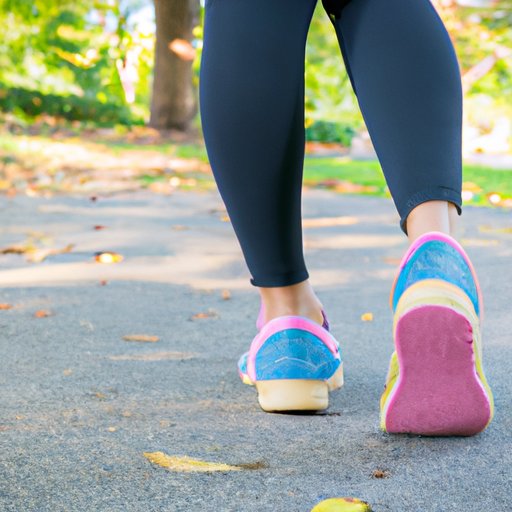
Introduction
Losing weight is a common goal for many people, but finding the right exercise routine can be challenging. Walking is a simple and effective way to incorporate exercise into your daily routine. It is an activity that most people can do, regardless of their fitness level. In this article, we will explore the benefits of walking for weight loss, step-by-step instructions on how to get started, creative ways to add walking to your daily routine, and how to maximize your workout for optimal weight loss results.
The Benefits of Walking for Weight Loss
Walking is an excellent low-impact exercise that can help you lose weight, especially if you are new to exercising. The benefits of regular walking go beyond weight loss, including improved cardiovascular health, stronger bones, and reduced risk of chronic diseases.
Walking burns calories, and it is an easy way to incorporate physical activity into our lives without the need for equipment or a gym membership. It helps to boost your metabolism, increase muscle mass, and can aid in reducing body fat. A brisk 30-minute walk can burn up to 200 calories, depending on your weight and speed.
The science behind walking is that it increases your heart rate, pumping blood and oxygen throughout your body. This process helps to burn calories and reduces the risk of heart disease and stroke. Walking also aids in reducing stress, improves sleep quality, and boosts energy levels.
Step by Step: How to Start Losing Weight by Walking
Before starting any exercise routine, it is essential to warm up and stretch to prevent injury or muscle strain. Start with gentle stretches and gradually increase your pace to get your heart rate up and prepare your body for activity.
Establishing a walking routine takes time and effort, but it can be an easy and enjoyable way to lose weight. Start by setting a goal that is measurable and attainable, such as walking for 30 minutes every day. Consistency is key to making progress towards your weight loss goals.
Setting realistic goals is essential in establishing a walking routine to lose weight. Make sure to start slow and gradually increase your pace and duration as your fitness level improves. It’s important to listen to your body and take breaks if needed, especially if you are new to exercising.
Mixing it up: Creative Ways to Incorporate Walking into Your Daily Routine
Walking doesn’t just have to be a workout; it can also be a means of transportation or a way to explore new places. Walking to work or for short errands can help to increase physical activity and reduce the need for a sedentary lifestyle.
Joining a walking group or walking with a friend can make your workouts more enjoyable and help to keep you accountable. Trying new walking routes or exploring new environments, such as parks or hiking trails, can add variety and excitement to your walking routine.

The Science behind Walking for Weight Loss: Why It Works and How to Maximize Your Results
The science behind walking for weight loss lies in the fact that it increases your heart rate, which in turn burns calories. The number of calories burned during a walk depends on factors such as your weight, speed, duration, and the terrain you are walking on.
To maximize your weight loss results while walking, it’s essential to increase your speed and duration gradually. Walking at a brisk pace, which is around 3–4 miles per hour, can help you burn more calories than walking at a leisurely pace. Increasing the duration of your walk can help you maintain an increased heart rate and burn more calories.
The Power of Consistency: How Making Small Changes to Your Walking Routine Can Make a Big Difference
Consistency is essential in reaching your weight loss goals through walking. Making small, incremental changes to your walking routine can help you stay consistent and reduce your risk of burnout or injury. Making walking a habit can help you achieve long-term weight loss results.
Ways to keep consistent with your walking routine include tracking your progress, setting reminders, and keeping a walking log. Accountability methods, such as working out with a friend or joining a walking group, can help you stay motivated and committed to your routine.
Step up Your Game: How to Make Your Walking Workout More Challenging
To increase the intensity of your walking workout, you can incorporate hills or stairs into your routine. Adding inclines to your route can help you burn more calories and strengthen your leg muscles. Incorporating strength training exercises, such as lunges or squats, during your walk can also help to increase your muscle mass and, therefore, burn more calories.
Walking and Beyond: How to Combine Walking with Other Exercise for Even Greater Weight Loss Results
Combining walking with other exercises can help you reach your weight loss goals faster. Strength training exercise can help to increase your muscle mass and, in turn, increase your metabolism. Yoga or pilates can improve flexibility and balance, while also providing a low-impact workout.
Cross-training is another way to increase overall fitness levels and reduce the risk of injury. Incorporating exercises such as swimming, cycling, or rowing, can help you work different muscles and avoid overuse injuries. It’s essential to start slow and gradually increase your workload when cross-training to reduce the risk of injury.
Conclusion
In conclusion, walking is an effective and simple way to lose weight and improve overall health. Starting a walking routine takes time and effort, but the results are worth it. Mix up your routine, keep consistent with your workouts, and gradually increase the intensity of your workouts to maximize your weight loss results. Walking can also be combined with other workouts to increase overall fitness levels and reduce the risk of injury.




